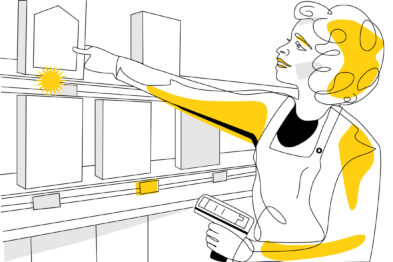Furniture labels enter the digital age
Across industries, retailers are entering the digital age by transforming their stores into cutting-edge digital spaces. Customers are now looking for a more connected experience, in which brick-and-mortar stores would be a more lively extension of their online counterparts, while still providing an equally seamless experience. Digital labels play a pivotal role in the furniture industry, connecting the worlds of brick-and-mortar shopping and online shopping. Discover the power of the VusionCloud IoT platform and smart electronic shelf labels for furniture.
Digital labels for furniture: what exactly are they? How do they work?
The Retail IoT VusionCloud platform, combined with electronic shelf labels for furniture, represents a complete labeling solution designed to optimize pricing and store management processes through automation. Once connected, hardware and software form a network of infinitely customizable home furnishings price tags, requiring minimal human intervention and providing customers with more compelling information than ever before.
Electronic shelf labels for furniture replace traditional paper labels. Their bright screen, which looks like paper, highlights descriptions and prices in a clear and dynamic way. The labels can even be rotated or tilted and are easy to remove.
But what makes them truly unique is how they revolutionize labeling processes! Instead of having to manually print and replace labels with every update or promotion, the system allows you to manage changes remotely and in real-time. It can also be configured to perform updates automatically.
Smart labels offer a completely new immersive experience, where customers can access product information and reviews from other users, just like when ordering online.
Why do furniture retailers need electronic shelf labels?
In the world of retail, and especially the world of furniture, digital price tags can really make a difference. They are transforming physical stores into automated, data-driven spaces, where everything is centered around connecting with suppliers and customers in real time. Smart electronic furniture shelf labels can improve store agility in many ways.
Accuracy of Pricing and Availability of Information
Manually replacing paper labels often means a delay in the dissemination of information, so that it is sometimes no longer relevant by the time it arrives on the shelf. In addition, displaying inaccurate or outdated information may cause you to lose sales; every time a consumer misses out on a promotion, for example!
Digital price tags for furniture allow store owners to rely on price automation and manage their labels in the cloud, updating prices and promotions instantly, with minimal effort and high accuracy.
The SESimagotag solution eliminates up to 100% of pricing errors and thus improves customer trust while avoiding complaints and the risk of fines. With highly reliable omnichannel synchronization, you can focus on increasing your sales and margins with confidence.
Improved Efficiency and Employee Satisfaction
Digital price displays in supermarkets and other stores eliminate the need for employees to perform repetitive, low-value tasks, freeing up more time to focus on optimal store management.
Electronic furniture shelf labels offer additional features such as product geolocation and real-time planogram management. These features allow assistants to locate products and pick orders faster, without having to run from aisle to aisle looking for a particular item. The OptiPick solution, for example, optimises the route to pick up products from the store’s shelves with a convenient digital map. This allows employees to take the quickest route and easily find the product they are looking for thanks to the 180° LED flash of the flashing labels on the shelf.
Improved inventory management and availability
Combined with SESimagotag EEG technology, computer vision uses real-time monitoring and machine learning to detect stock-outs, misplaced products, and other anomalies. As a result, not only can store teams replenish shelves on the shelves more efficiently, but suppliers can also be notified when stocks are running out, if applicable.
Regardless of the industry, from furniture labels to pharmacy shelf labels, the network can always be fully centralized. You’ll never miss a sale again because you’re out of stock.
Seamless in-store shopping experience and increased customer satisfaction
The future of shopping is experiential shopping! Digital price tags for furniture can be used as the basis for connected services based on local needs, technology trends, and operational requirements (inventory information, synchronized promotions, user reviews, Scan & Go, etc.). NFC and QR technologies, now integrated into digital labels, allow customers to view personalized information through the labels, but they can also access additional details via their smartphones.
Displaying rich content in a physical store encourages shoppers to learn more about products, just as they would online. Digital furniture labels are the ideal medium for conducting in-store marketing campaigns in real-time.
How to choose the right digital labeling solution for the furniture trade?
Regardless of the type of store in question (fruit and vegetable or furniture, for example), deploying a digital labeling solution can help the retailer increase their performance. The versatility of these systems makes the integration process much easier. In addition, thanks to the remote capabilities and the relevance of the software solution, learning is fast and employees can start saving time almost instantly.
Initially, the replacement of paper labels with digital labels can be done gradually, updating the information as it happens. Once the entire network is in place, you can start interacting with all price tags in real-time and use consistent language across the store.
The Future of Furniture Retail: Trends in Digital Price Tag Technology
The mobile phone is poised to become the most important element of the omnichannel experience, and digital price tags fit perfectly into this trend, integrating mobile technologies into the in-store shopping environment.
It’s also how rapidly growing e-commerce can make its way into brick-and-mortar stores, allowing customers to experience products in person and use augmented reality to interact with them in a completely new way. This is especially relevant for forward-thinking furniture companies that are already leveraging 3D. All the customer needs to do is scan a digital label using a smartphone to access a whole new experience.
Reviews left by other users provide useful information to customers who value objective feedback: Smart labels can give shoppers access to these reviews and can also invite them to view user-generated visual content that will help them on their shopping journey.

